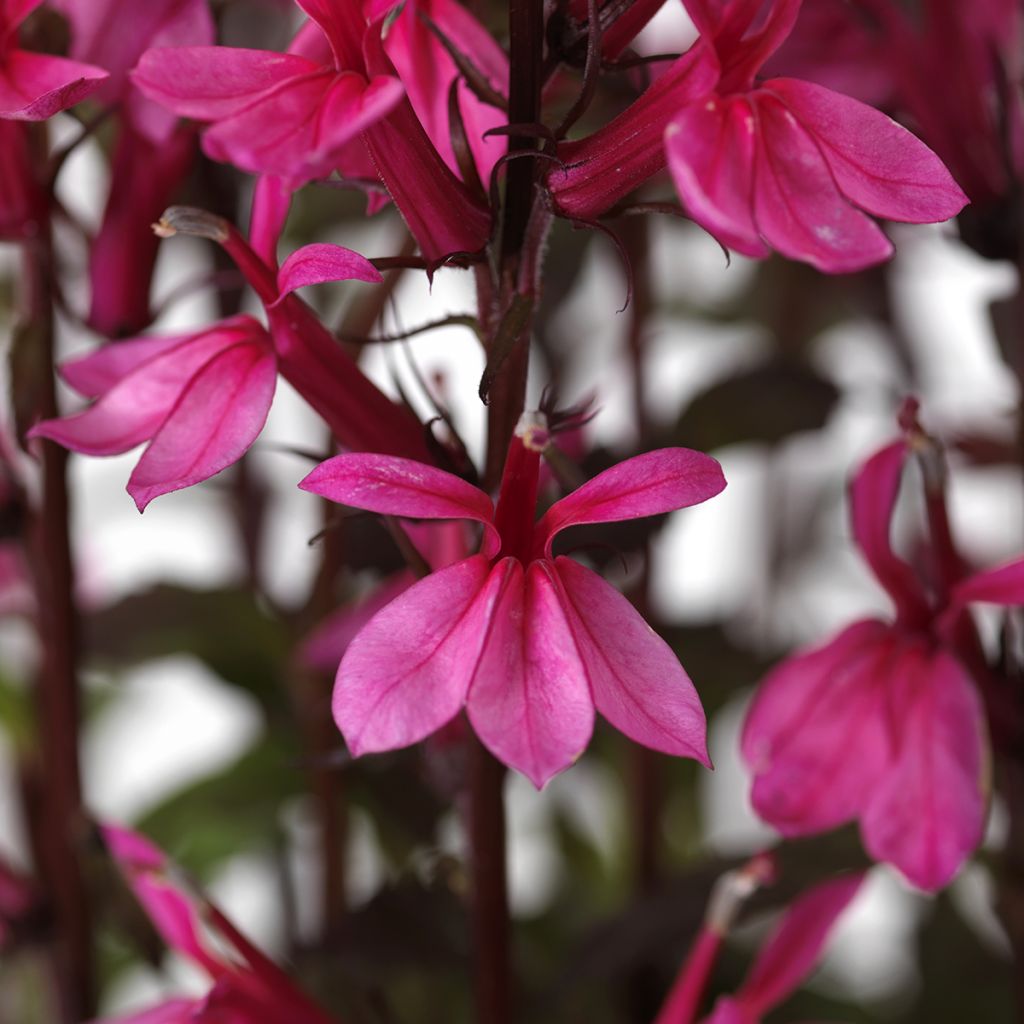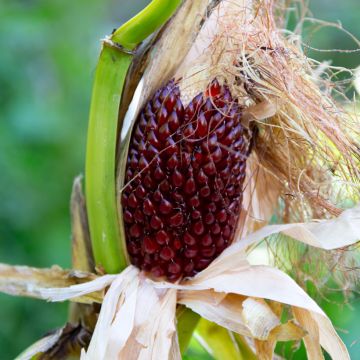

Lobelia speciosa Starship Rose seeds
Lobelia speciosa Starship Rose seeds
Lobelia x speciosa 'PAS1302714' Starship Rose
Garden Lobelia, Cardinal Flower
Special offer!
Receive a €20 voucher for any order over €90 (excluding delivery costs, credit notes, and plastic-free options)!
1- Add your favorite plants to your cart.
2- Once you have reached €90, confirm your order (you can even choose the delivery date!).
3- As soon as your order is shipped, you will receive an email containing your voucher code, valid for 3 months (90 days).
Your voucher is unique and can only be used once, for any order with a minimum value of €20, excluding delivery costs.
Can be combined with other current offers, non-divisible and non-refundable.
Home or relay delivery (depending on size and destination)
Schedule delivery date,
and select date in basket
This plant carries a 6 months recovery warranty
More information
We guarantee the quality of our plants for a full growing cycle, and will replace at our expense any plant that fails to recover under normal climatic and planting conditions.
Would this plant suit my garden?
Set up your Plantfit profile →
Description
Lobelia 'Starship Rose' is a very beautiful, floriferous perennial plant for moist to wet soil, well-suited to container cultivation and for borders or banks. From summer to autumn, this variety develops purple flowering stems adorned with bright pink flowers that attract pollinators. Its dense foliage and prolonged flowering make it an excellent accent plant, both in naturalistic settings and in more formal compositions.
Lobelia × speciosa 'Starship Rose' is a herbaceous perennial plant from the Campanulaceae family. It is one of many hybrids resulting from the cross-breeding between several North American species, particularly Lobelia cardinalis, Lobelia siphilitica and Lobelia fulgens. All grow in damp places such as riverbanks, marshy areas and wet meadows.
The 'Starship Rose' cultivar is part of the 'Starship' series, developed by PanAmerican Seed, which also includes varieties with red and blue flowers. It was selected particularly for its earlier flowering and better branching. The hybrid lobelia 'Starship Rose' forms a dense clump of sturdy stems coloured purple to burgundy. It reaches 50-60 cm in height with a spread of 30 cm in the ground. In a pot, it reaches about 40 cm in height. Its dimensions are perfectly suited to 5 to 7 litre containers. The flowering period extends from June-July to September-October in the form of dense spikes of bright pink flowers along the stems. Each flower measures 2 to 3 cm long with a tubular corolla with 5 lobes. The two upper lobes are smaller and erect, while the three lower lobes are wider and spreading, forming a prominent lower lip. Pollination is carried out by bees, bumblebees and especially butterflies, attracted by the bright colour of the flowers. The dark green leaves are lanceolate, measuring between 5 and 8 cm long and grouped at the lower part of the stems. The plant enters dormancy during winter and regrows from the base the following spring. A well-protected crown can withstand temperatures down to -8/-10 °C at the lowest.
Lobelia speciosa 'Starship Rose' will perform at its best in rich, moist soils in summer. Grown in a pot, it will need frequent watering and fertiliser, but it is worth the effort! For companion planting, choose plants with decorative foliage or soft flowering, such as Heuchera 'Forever Purple' with luminous purple foliage or Carex oshimensis 'Evergold' with fine variegated leaves, which will highlight its bright pink spikes and purple stems. This variety can even serve as a focal point in a container display, combined with some well-chosen annuals like Petunia Supertunia Vista 'Bubblegum' for a colour echo and Coleus Copinto 'Manhattan' for its very dark foliage.
Coated seeds are seeds surrounded by a thin protective layer, composed of clay, nutrients or a natural binder. This process facilitates their handling, particularly for very small seeds like those of lobelia, by making them larger and more regular. The coating also improves sowing precision, promotes more uniform germination, and can sometimes contain elements beneficial to germination.
Flowering
Foliage
Plant habit
Botanical data
Lobelia
x speciosa
'PAS1302714' Starship Rose
Campanulaceae
Garden Lobelia, Cardinal Flower
Cultivar or hybrid
Planting and care
Sow Lobelia Starship Rose seeds from January to March to flower in pots from July, or from April to May for outdoor cultivation. Sow the seeds on the surface, without covering them, as they need light to germinate. Maintain a constant temperature of 21°C and high humidity to encourage germination, which usually occurs within 10 to 14 days.
Once the seedlings are well developed, transplant them individually into pots 10 to 15 cm in diameter.
Growing:
Lobelia ‘Starship Rose’ prefers a humus-rich, well-drained soil with a pH between 6.0 and 7.0. It enjoys sunny to partially shaded exposures. Plant it outdoors after the last frosts, spacing the young plants 30 to 40 cm apart. Water regularly to keep the soil moist, especially during dry periods. Apply a balanced fertiliser every two weeks to support growth and flowering.
In winter, protect the crown with a thick mulch to prevent frost damage, especially in regions with harsh winters.
Sowing period
Intended location
Planting & care advice
This item has not been reviewed yet - be the first to leave a review about it.
Similar products
Haven't found what you were looking for?
Hardiness is the lowest winter temperature a plant can endure without suffering serious damage or even dying. However, hardiness is affected by location (a sheltered area, such as a patio), protection (winter cover) and soil type (hardiness is improved by well-drained soil).

Photo Sharing Terms & Conditions
In order to encourage gardeners to interact and share their experiences, Promesse de fleurs offers various media enabling content to be uploaded onto its Site - in particular via the ‘Photo sharing’ module.
The User agrees to refrain from:
- Posting any content that is illegal, prejudicial, insulting, racist, inciteful to hatred, revisionist, contrary to public decency, that infringes on privacy or on the privacy rights of third parties, in particular the publicity rights of persons and goods, intellectual property rights, or the right to privacy.
- Submitting content on behalf of a third party;
- Impersonate the identity of a third party and/or publish any personal information about a third party;
In general, the User undertakes to refrain from any unethical behaviour.
All Content (in particular text, comments, files, images, photos, videos, creative works, etc.), which may be subject to property or intellectual property rights, image or other private rights, shall remain the property of the User, subject to the limited rights granted by the terms of the licence granted by Promesse de fleurs as stated below. Users are at liberty to publish or not to publish such Content on the Site, notably via the ‘Photo Sharing’ facility, and accept that this Content shall be made public and freely accessible, notably on the Internet.
Users further acknowledge, undertake to have ,and guarantee that they hold all necessary rights and permissions to publish such material on the Site, in particular with regard to the legislation in force pertaining to any privacy, property, intellectual property, image, or contractual rights, or rights of any other nature. By publishing such Content on the Site, Users acknowledge accepting full liability as publishers of the Content within the meaning of the law, and grant Promesse de fleurs, free of charge, an inclusive, worldwide licence for the said Content for the entire duration of its publication, including all reproduction, representation, up/downloading, displaying, performing, transmission, and storage rights.
Users also grant permission for their name to be linked to the Content and accept that this link may not always be made available.
By engaging in posting material, Users consent to their Content becoming automatically accessible on the Internet, in particular on other sites and/or blogs and/or web pages of the Promesse de fleurs site, including in particular social pages and the Promesse de fleurs catalogue.
Users may secure the removal of entrusted content free of charge by issuing a simple request via our contact form.
The flowering period indicated on our website applies to countries and regions located in USDA zone 8 (France, the United Kingdom, Ireland, the Netherlands, etc.)
It will vary according to where you live:
- In zones 9 to 10 (Italy, Spain, Greece, etc.), flowering will occur about 2 to 4 weeks earlier.
- In zones 6 to 7 (Germany, Poland, Slovenia, and lower mountainous regions), flowering will be delayed by 2 to 3 weeks.
- In zone 5 (Central Europe, Scandinavia), blooming will be delayed by 3 to 5 weeks.
In temperate climates, pruning of spring-flowering shrubs (forsythia, spireas, etc.) should be done just after flowering.
Pruning of summer-flowering shrubs (Indian Lilac, Perovskia, etc.) can be done in winter or spring.
In cold regions as well as with frost-sensitive plants, avoid pruning too early when severe frosts may still occur.
The planting period indicated on our website applies to countries and regions located in USDA zone 8 (France, United Kingdom, Ireland, Netherlands).
It will vary according to where you live:
- In Mediterranean zones (Marseille, Madrid, Milan, etc.), autumn and winter are the best planting periods.
- In continental zones (Strasbourg, Munich, Vienna, etc.), delay planting by 2 to 3 weeks in spring and bring it forward by 2 to 4 weeks in autumn.
- In mountainous regions (the Alps, Pyrenees, Carpathians, etc.), it is best to plant in late spring (May-June) or late summer (August-September).
The harvesting period indicated on our website applies to countries and regions in USDA zone 8 (France, England, Ireland, the Netherlands).
In colder areas (Scandinavia, Poland, Austria...) fruit and vegetable harvests are likely to be delayed by 3-4 weeks.
In warmer areas (Italy, Spain, Greece, etc.), harvesting will probably take place earlier, depending on weather conditions.
The sowing periods indicated on our website apply to countries and regions within USDA Zone 8 (France, UK, Ireland, Netherlands).
In colder areas (Scandinavia, Poland, Austria...), delay any outdoor sowing by 3-4 weeks, or sow under glass.
In warmer climes (Italy, Spain, Greece, etc.), bring outdoor sowing forward by a few weeks.


















































